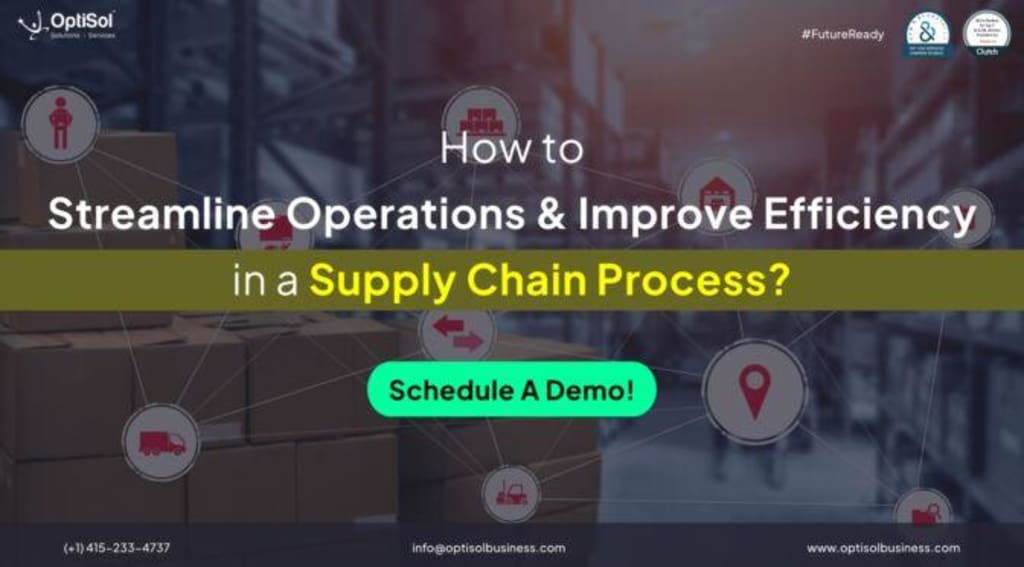How to Streamline Operations and Improve Efficiency in a Supply Chain Process?
Supply Chain Process

KEY HIGHLIGHTS
- The article outlines five key strategies for effective supply chain management: using advanced technology, better forecasting and demand planning, optimizing inventory management, leveraging technology for visibility, and monitoring and measuring performance.
- Streamlining the supply chain process offers significant benefits like cost reduction, enhanced customer satisfaction, improved agility, optimized resource allocation, and data-driven decision making.
- The article emphasizes that automation, real-time visibility, and data-driven insights are key to achieving these benefits
5 Key Strategies for Effective Supply Chain Management
Integrate Advanced Technology: Implement advanced SCM software for real-time visibility into the supply chain. Automation of tasks like order processing and invoicing reduces errors and speeds up processes. This leads to better decision-making and quicker market responses.
Forecasting and Demand Planning: Use predictive analytics and machine learning to forecast demand based on historical data and trends. Collaborate with suppliers and customers to align production with actual needs. This ensures inventory optimization and a responsive supply chain.
Optimize Inventory Management: Adopt Just-In-Time (JIT) systems to minimize holding costs by synchronizing inventory with production schedules. Utilize optimization tools to determine optimal stock levels and reorder points. This approach balances supply and demand efficiently.
Technology-Driven Visibility: Leverage IoT devices for real-time tracking of goods and blockchain for secure transactions. Advanced analytics and dashboards help monitor the supply chain, identify inefficiencies, and address issues proactively. This enhances transparency and control.
Monitor and Measure Performance: Set clear KPIs for various aspects of the supply chain, such as order accuracy and delivery times. Regular audits and performance reviews provide data-driven insights for continuous improvement. This ensures the supply chain remains agile and efficient.
The Importance of Streamlining Your Supply Chain Process
Cost Efficiency: Streamlining your supply chain process can lead to significant cost savings. By optimizing inventory management, reducing waste, and enhancing procurement practices, companies can lower operational expenses and improve their bottom line.
Enhanced Customer Satisfaction: A streamlined supply chain ensures timely deliveries and higher product quality, leading to increased customer satisfaction and loyalty. By improving order accuracy and reducing lead times, companies can meet customer expectations more effectively.
Improved Agility and Flexibility: Streamlining the supply chain enhances agility and flexibility, enabling companies to respond quickly to changes in market demand and supply chain disruptions. This adaptability helps maintain business continuity and sustain competitiveness in dynamic environments.
Optimized Resource Utilization: Efficient supply chain processes optimize resource utilization, including labor, materials, and transportation. By eliminating inefficiencies and maximizing productivity, companies can achieve higher output with fewer resources, driving greater efficiency.
Data-Driven Decision Making: A streamlined supply chain enables data-driven decision-making through real-time visibility and analytics. By leveraging data insights, companies can identify opportunities for improvement, anticipate market trends, and make informed strategic decisions to drive business growth.
What are the benefits of Streamlining your Supply chain process?
Efficiency and Productivity: Automating tasks reduces errors and speeds operations. Advanced SCM software enhances coordination and decision-making, eliminating bottlenecks and increasing productivity.
Customer Satisfaction: Efficient logistics ensure timely deliveries and high product quality, reducing returns and complaints. Responsive service enhances satisfaction and loyalty, driving repeat business.
Flexibility and Agility: Streamlined supply chains quickly adapt to market changes and disruptions. Efficient processes and real-time data enable scalable operations, ensuring business continuity and innovation.
Cost Reduction: Streamlining the supply chain cuts costs by optimizing resources and improving procurement practices. Just-In-Time (JIT) inventory minimizes holding costs, boosting profitability.
Data-Driven Decisions: Advanced analytics provide insights for informed decisions. KPIs and audits ensure continuous improvement, while real-time monitoring allows proactive issue resolution and risk reduction.
About the Creator
Enjoyed the story? Support the Creator.
Subscribe for free to receive all their stories in your feed. You could also pledge your support or give them a one-off tip, letting them know you appreciate their work.





Comments
There are no comments for this story
Be the first to respond and start the conversation.